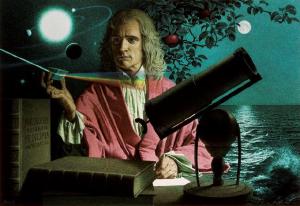Post
Fiat Lux
20 April 2013
 Jean Leon Huens
Jean Leon HuensIn 1671, Isaac Newton submitted a letter to the the Royal Society outlining a new theory of light and color.1 While Newton is probably most famous for his theory of gravity—and the mythical apple—he was also deeply interested in the nature of light, and made one of the first detailed studies of the properties of light. The work he describes in this 1671 paper is so brilliantly simple you can do it at home. All you need is some sunlight and a couple of prisms.
In Newton’s time it was already well known that light passing through a prism would produce a spectrum of colors. It was generally thought that the color must somehow be contained within the prism glass, and when light passed through a prism it would be tinted various colors. Newton was able to clearly show this was not the case. To show this, Newton sealed off a room from light except for a small hole in a window shutter, so that a single beam of light could enter. He then placed the prism over the hole, so that the light would pass through the prism and project onto a far wall. He saw the expected spectrum of colors, but he noticed something unusual. The original hole was circular, but the spectrum on the wall was oblong. This was unexpected. If the colors appeared because the light was tinted by the prism, then the light beam shouldn’t change shape from circular to oblong. What’s more, Newton noticed that the spectrum had sharp edges along its long sides, but fuzzy edges at its short sides.
This gave him the idea that white light might contain within it all the colors of the spectrum, and that each color was bent by the prism slightly differently, thus producing the smeared spectrum. To test his idea, Newton measured the angles by which each color was bent (refracted), and he found that red was consistently bent by a certain angle, while violet was consistently bent by a certain larger angle. This was true for all the colors in between as well. The prism bent each color of light by a particular angle, with red bent least and violet bent most. What Newton seemed to show was that light was not naturally white, being tinted when striking the prism. Rather, light was made of colors revealed by the prism and its variable refraction.
But how could Newton prove that this was the case? After all, it was possible that the prism did color light passing through it as well as bending colors differently. How could he show that color was a property of light, and not a prism. To prove his theory, Newton made a board with small hole and positioned it so that only the red part of the light passed through the hole. He then placed a second prism over the hole so that the red light passed through the prism and struck the far wall. If color was caused by the prism, then one would expect to see a full spectrum once again. What Newton saw was a single circle of red light. When he measured the refraction of the light through the second prism, it was the same as through the first prism. Newton did this with several colors, and always found the same result. The prism never colored the light, it simply refracted it according to its color. Light was therefore not a simple featureless thing. It possessed some intrinsic structure we perceive as color.
Through his work, Newton took the first step toward our understanding of the complexity and subtlety of light.
Newton, Isaac. “A letter of Mr. Isaac Newton, professor of the mathematicks in the University of Cambridge; containing his new theory about light and colors: Sent by the Author to the Publisher from Cambridge, Febr. 6. 1671/72; In Order to be Communicated to the R. Society.” Philosophical Transactions of the Royal Society of London 6.80 (2014): 3075-3087. ↩︎